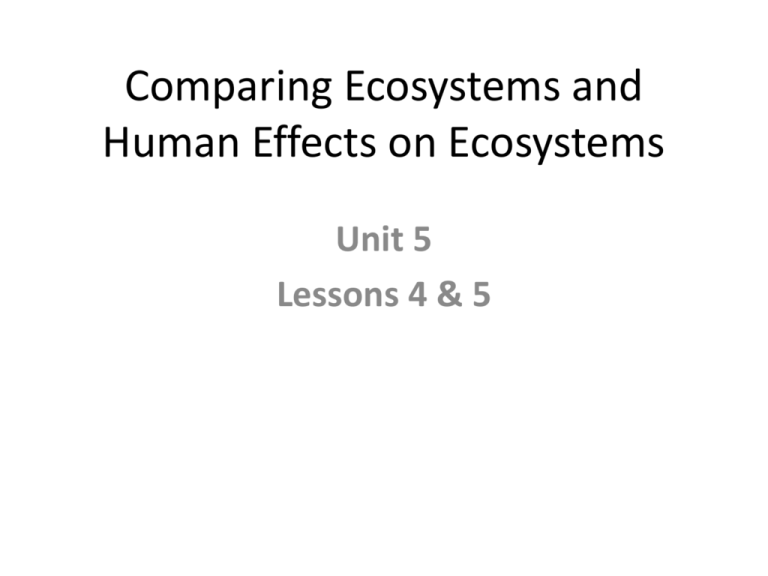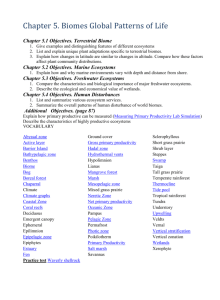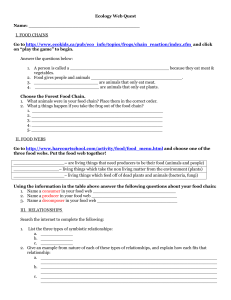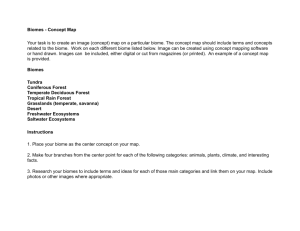Comparing Ecosystems and Human Effects on Ecosystems
advertisement

Comparing Ecosystems and Human Effects on Ecosystems Unit 5 Lessons 4 & 5 Vocabulary • 1. biome – • one of Earth’s major land ecosystems, each with its own kind of climate, soil, plants and animals • 2. wetlands – • An ecosystem where water is near the surface of the soil much of the time 3. estuary – • The boundary where a freshwater ecosystem meets a saltwater ecosystem 4. pollution – • The addition of harmful substances to the environment 5. Litter – • Trash that is unlawfully disposed of outside 6. Smog – • A type of air pollution formed by particles produced by burning fossil fuels 7. Ozone – • A form of oxygen gas forming a layer in Earth’s atmosphere that screens out much of the Sun’s ultraviolet rays 8. Pollutant – • A substance that pollutes a material 9. non-native species – • Also called exotic species, plant and animal species that have been introduced into an environment that is outside their native range • 10. climate – • The average weather pattern for a region 11. What biome is Louisiana in? • Louisiana is in the deciduous forest biome, but there are several different types of ecosystems located within Louisiana 12. What are some ecosystems in Louisiana? • • • • • • Wetlands, freshwater deciduous forests Ponds, freshwater Rivers, freshwater Lakes, freshwater Gulf (considered to be an ocean ecosystem) 13. How are streams and rivers different from ponds and lakes? • Ponds and lakes contain non-moving water year-round • Streams and rivers have moving water 14. Would you find the same organisms in each of these ecosystems? Why? • No. Each of these ecosystems has different types of organisms, but some organisms can be found in more than one ecosystem. 15. What are some organisms you would find in a wetland? • • • • Frogs Fish Birds Algae and many different types of plants 16. What are the six major land ecosystems? • Tundra • Taiga - coniferous evergreen forests of subarctic lands, covering vast areas of northern North America and Eurasia. • • • • Desert Grassland Rain forest Deciduous forest 17. What makes these six ecosystems different from on another? • The climates, animals that live there, plants that live there, amounts of water • Earth’s ecosystems are not just restricted to land • Most of Earth is covered with water ecosystems. 18. What types of water ecosystems exist on Earth? • • • • • Freshwater Saltwater Ponds, lakes, streams, rivers, wetlands Estuaries Oceans 19. Why do ecosystems near the equator have more organisms than in the polar regions? • Areas closer to the equator receive more direct sunlight than areas closer to the poles. 20. What are the names of three ecosystems with harsh climates? • Tundra • Taiga • Desert 21. What factors make these climates harsh? • Extremely hot or cold temperatures; very little precipitation 22. Tundra • Found in far northern regions • Very cold winters and short summers • A tundra is a cold, dry biome that includes a layer of permanently frozen soil called permafrost • In the Northern Hemisphere, tundras circle the land just south of the north pole 23. Taigas • Found south of the northern tundras • A cool forest of cone-bearing evergreen trees • Winters are cold, and the short summers are warm, wet, and humid • Summer conditions encourage insect reproduction, which in turn attracts many migrating birds 24. Deserts • Found on every one of Earth’s continents • Not all deserts are hot • Some deserts are located in cold regions near the South Pole • All deserts are dry; they receive less than 10 inches of rain 25. What are the characteristics of grassland ecosystems? • Main plants are grasses; not much rainfall, warm summers and cool winters, windy • Grasslands are sometimes called prairies 26. What are the differences between a tropical rain forest and a deciduous forests? • Tropical rain forest; warm, humid climate; much rainfall; located near the equator. • Deciduous forest: trees lose leaves during fall and winter; warm summers and cold winters 27. Why are wetlands important ecosystems? • They are rich in plant life, homes to many living things and important breeding grounds for birds and other animals. • They also serve as a natural water filters and sponges by removing pollutants and protecting surrounding land from floods and erosion. 28. Why are estuaries unique ecosystems? The water is part salt water and part freshwater The plants and animals that live in estuaries have adaptations that help them survive in variations in salt content, or salinity 29. Wetlands About 40% of the wetlands in the continental United States are in Louisiana. Wetlands include marshes, swamps and bogs 30. Ocean food chains • Includes plankton, nekton and benthos 31. Plankton o Live near the ocean’s surface o They make up the base of the ocean food chain. 32. Nekton • Squid, fish and dolphins, swim through the water 33. Benthos • Crabs, sponges and corals, are bottomdwelling animals that live on or near the oceans floor 34. What are the three ocean zones? Intertidal zone (close to shore) Neritic zone Oceanic zone 35. Which ocean zone would not have algae growing on the ocean floor and why? The oceanic zone because sunlight cannot reach the floor of the ocean. 36. How does depth affect ocean water’s temperature? Temperature decrease as depth increase. 37. What are the problems holes in the ozone layer may cause? Holes in Earth’s ozone are a problem because they allow dangerous rays from the Sun to reach earth’s surface. These rays can cause skin cancer. Smog can cause breathing problems 38. What is the best way to protect our water resources? The best way to protect our water resources is to prevent water pollution. 39. How is a biome different from other habitats? A biome is a set of habitats or ecosystems all grouped together into a kind of “superecosystem”. 40. How are ecosystems near the equator different from ecosystems in the polar regions? Ecosystems near the equator are rich with plants and animals, while fewer organism live in Earth’s polar regions. 41. Effects of permafrost Prevents trees and large plant from developing deep roots Lichen, mosses, grasses, flowers and low shrubs with shallow root systems can grow above the permafrost 42. What are some ways in which soil can become polluted? Waste that’s not disposed of properly Underground storage tanks can leak Chemicals used on crops can get in the soil Landfills that are not properly constructed, can leak Litter from humans 43. What are some negative effects of soil pollution on the environment? Harmful substances can be washed into streams and rivers Soil chemistry can change The health of humans and other organisms can be affected 44. What are some ways in which water can become contaminated or polluted? Chemicals used on crops and on lawns can seep into groundwater Water running over streets can pick up contaminants Animal waste can get washed into streams and lakes, when it rains 45. What laws are in place to protect water resources? • The Safe Drinking Water Act and the Clean Water Act 46. What are some ways people could prevent water pollution? Reduce or eliminate the use of chemical on their lawns Dispose of garbage properly Plants trees or shrubs to absorb chemicals, animals waste and sediment Test Prep 47. Most of Earth’s water is in the salty oceans. Based on this fact, what can be inferred about Earth’s freshwater? • There is a limited supply of freshwater









